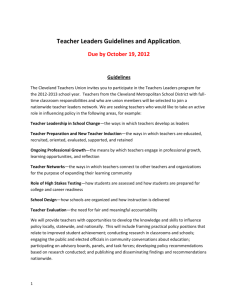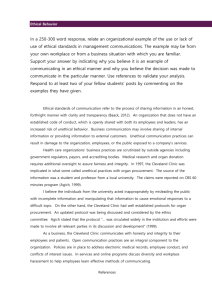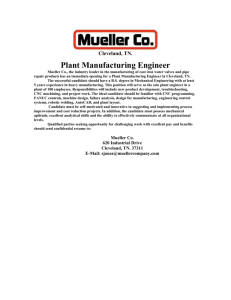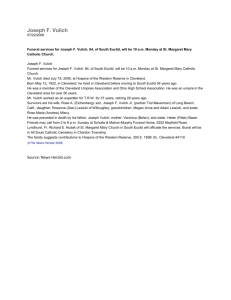2010 State of the City
advertisement
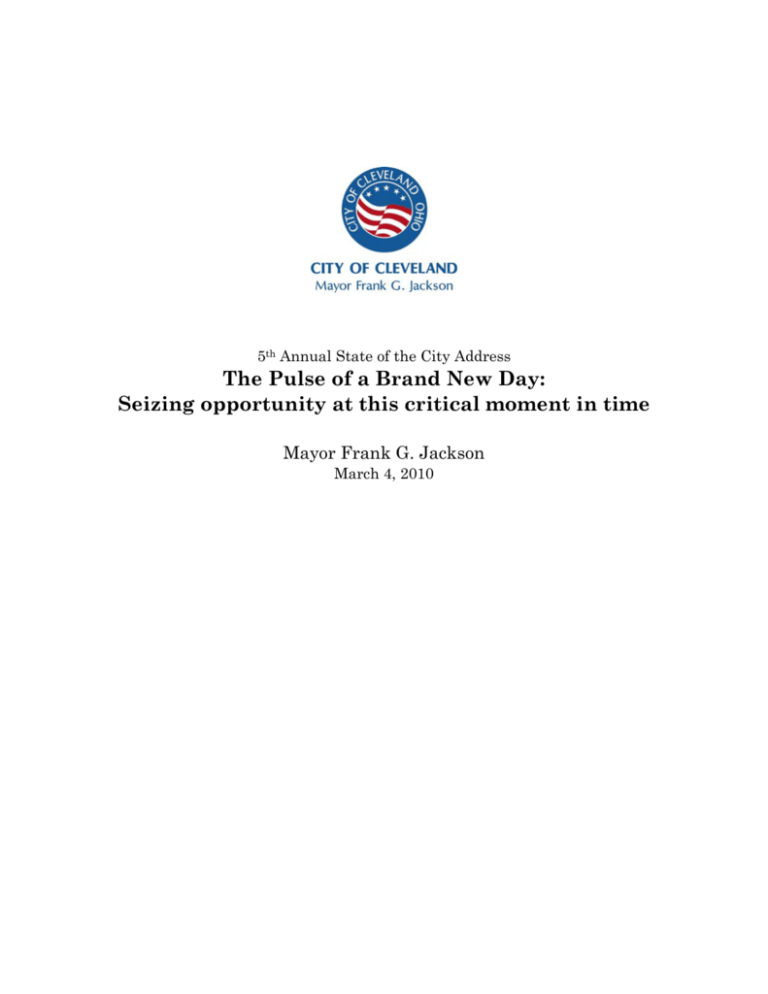
5th Annual State of the City Address The Pulse of a Brand New Day: Seizing opportunity at this critical moment in time Mayor Frank G. Jackson March 4, 2010 Good afternoon. Thank you for the introduction and thank you to the City Club of Cleveland for once again hosting my state of the city address. Council President Sweeney, members of council and all elected officials, members of my cabinet, clergy and our community – thank you for joining me today. For the past four years, I have worked to position Cleveland and the region to take advantage of opportunities that can improve the quality of life in our neighborhoods, improve our economy, position Cleveland for the future and better educate our children. At the same time, we have seen a global recession, business failures, residential and commercial foreclosures, an increase in unemployment, and an increase in the need for government services while revenue is declining. The world that we are living in continues to change at a rapid pace. The demographics of who are impoverished, unemployed and undereducated have expanded; and the social and economic impact of a down economy has spread from urban centers to suburban communities. 2010 will be a pivotal year in Cleveland’s history. The work I have done over the last four years, the decisions I have made and the actions I have taken have positioned us – as a city – for this moment in time. • A time to build on the foundation that has been laid over the last four years; • A time to continue acting on the decisions that have been made, creating stability, certainty and direction for the future; • A time to set our priorities, together, so that we change how we operate in order to benefit our regional economy, our community and all of our children. It will not be easy, but the decisions we make today – as a community – will ensure our social and economic future, not only for tomorrow, but for decades to come. If we come together, at this pivotal time, the changes we bring about will be well worth the work we put into making them happen. As President John F. Kennedy once said: “There are risks and costs to a program of action. But they are far less than the long-range risks and costs of comfortable inaction.” There has never been a better time for change, economically, socially and politically. The United States and the world are experiencing the worst economic crisis since the Great Depression. This crisis began in the real estate market but soon spread throughout our economy. Interbank lending was disrupted and financial activity froze; and, in 2008, the demise of Bear Stearns, IndyMac Bank and Lehman Brothers escalated the panic beyond Wall Street to Main Street and the rest of the world. The International Monetary Fund estimated that large U.S. and European banks lost more than $1 trillion on toxic assets and bad loans from January 2007 to September 2009. Some American car companies, once our country’s industrial giants, filed for bankruptcy. Small- and medium-sized businesses throughout the country failed when the credit market and the economy froze.1 The drastic changes in the global financial and economic system created the volatility and uncertainty that remain today. The loss of jobs and closing of businesses have resulted in less revenue for local governments and has created budget deficits. Our local economy and governments, of course, are not exempt from the current recession. The economic downturn has had a significant impact on the City of Cleveland operating budget for the last two years. The City ended 2009 with a balanced budget, no layoffs and no reductions in service. This did, however, require the use of a large portion of our carryover balance. Municipalities across the country have been cutting service and laying off staff since 2008. Our ability in managing the budget crisis through 2009 is the result of four years of taking a proactive approach. In 2006, we began with a 5-year budget projection. At that time, we anticipated a deficit in fiscal 2010. In an attempt to avoid a deficit in 2010 and each preceding year, we instituted a 3% reduction in operating cost in 2006 that has been carried over each year. • We formed the Operations Efficiency Task Force and Clean Cleveland to promote efficiency and the sharing of resources. • We mandated energy conservation and reductions in fuel use. • We instituted overtime management primarily in the Departments of Public Safety and Public Service and implemented a citywide hiring freeze, except for critical positions. • We enforced a reduction in the purchase of supplies and materials and restricted travel to required skill certification or necessary job activities. However, the duration and depth of the economic crisis had a greater impact on the 2010 operating budget than was anticipated. In 2009, the City of Cleveland lost $24 million in income tax – a corresponding loss of $1.2 billion in payroll. This loss, along with other lost revenue, resulted in a budget deficit for 2010. To help address the 2010 budget gap, I commissioned a management and efficiency study early in 2009. In the fourth quarter of last year, the report was received, containing 175 recommendations on how to increase cost savings, increase revenue and increase efficiency. We acted immediately on a few of the recommendations, including a new fee to help recover some of the cost of waste collection. These measures, along with employee-approved furlough days and reductions in employee benefits and minimal layoffs, helped balance the 2010 budget. 2010 will continue to be fiscally challenging but we will maintain a balanced budget. My goal is to do it in a way that protects necessary staffing levels and continues the delivery of quality services throughout the City of Cleveland. Delivering quality service is a priority for me, even during this economic turmoil. Despite falling revenue, the City of Cleveland has been able to increase service over the last four years. Here are just a few examples of our success: • Attendance at our recreation centers increased by 25% over the last four years; • The Senior Initiative, a multi-department collaboration, has helped more than 200 senior citizens resolve housing and quality of life issues; • EMS response time for critical calls is well below the national average; • In 2007, the first police academy since 2001 graduated; since then four more classes have graduated; two police entrance exams were given; and, one police promotional exam was given – all to help maintain police staffing levels; • A fire cadet class graduated in 2009 and we will give a fire entrance exam this year; • For the 2009 flu season, the Division of Health distributed 68% more seasonal flu shots than the year before; and, • The City’s health centers increased HIV testing by 72% since 2006. Our neighborhoods have also continued to be a priority, despite hard economic times. We used our five-year capital improvement program to target our investments. Since 2006, more than $72 million has been invested in our roads, bridges, streetscapes, rec centers, playgrounds and parks. In 2009, Building & Housing issued more than 15,000 permits, reflecting more than $900 million in investments in Cleveland, a 24% increase in the amount of investment since 2006. More than 4,000 condemned structures have been demolished since 2006. The city razed 1,700 structures in 2009 alone, seven times more than in 2006. By comparison, last year: • Detroit demolished 920 structures out of an estimated 100,000 vacant houses; • Buffalo demolished about 700 vacant structures out of an estimated 25,000; and, • In Pittsburgh, 708 structures out of about 13,000 vacant structures were razed. Cleveland’s aggressive demolition strategy has helped reduced the number of vacant and distressed properties in the City of Cleveland from more than 8,000 in June 2008 to about 6,800 today, a nearly 15% drop. These efforts help make our neighborhoods better places to live and take away the opportunity for vacant structures to become places for criminal activity. Thanks to the hard work of our police force, an improved police deployment plan; the increased use of crime analysis tools and technology, and strong partnerships with local and federal law enforcement agencies, violent crime is down in nearly every category, including arson, assault, rape and burglary, compared to 2006. However, over the last four years homicides increased by less than 1%, primarily as a result of three incidents of multiple homicides last year – five people lost their lives in a tragic case of domestic violence on W. 89th; four people were killed in a boarding house arson fire on the near Westside; and, 11 women were killed on Imperial Avenue. Each of these cases has touched us, not just in Cleveland, but as an entire community. And they are pointed reminders of the work still to be done. Later this month, I will receive a report from the Commission on Sex Crimes and Missing Persons that I formed in the wake of the Imperial Avenue case. The report will help us to know what has to be done to handle these types of cases in the future. But all of this progress in improving quality of life is not enough. City departments will continue to work on finding better and more efficient ways to provide service, quality of life and safety and to invest in our neighborhoods, residents and businesses. But providing service to this city costs money. While we have done an outstanding job at reducing our operating costs, we will need to increase our revenue to continue to move forward. This can be accomplished through self-help. In my 2008 State of the City speech, I called on both the public and private sectors to invest an additional 3% of what we spend on purchasing goods and services into our regional economy. This would result in billions of additional dollars invested in our economy, help local companies stay in business, job retention, and job growth. Since then, I have increased the city’s local procurement efforts. In 2008, the City of Cleveland spent 61% of our procurement dollars in a five-county region, with 40% going to Cleveland businesses. In 2009, the City spent 72% in the region, with 49% going to Cleveland businesses. The Cleveland Small Business program, which focuses on local companies, including minority- and female-owned businesses met or exceeded nearly all of our own goals for hiring CSB-certified companies. This year, we’ve submitted legislation to Cleveland City Council – for their review and approval – that would offer additional incentives to local companies who bid on Cleveland projects based on one or more of the following criteria: • The company meets the City’s definition of a local sustainable company; • The company produces or processes goods within the region; or, • In the case of city contracts for food service, the company purchases food from northeast Ohio farmers or producers. In 2009, the City’s Department of Economic Development and the city’s loan review committee approved $95 million in assistance to businesses and development projects. These grants and loans will help create more than 2,500 new jobs. And, already this year, we’ve announced that Rosetta, a digital marketing company, is bringing 400 jobs to downtown Cleveland. The work that Economic Development is doing to attract new businesses and stimulate jobs is enhanced by a number of significant projects that are set to get under way in the near future, including: the Flats East Bank project, the Medical Mart and Convention Center, a downtown casino, the State Behavioral Health Facility and the Uptown Project at Mayfield and Euclid. Combined this is more than $1 billion in investment in Cleveland; and these projects will create construction jobs and permanent jobs in hospitality, tourism and health care. As you can see, the work of the last four years has brought us to this moment. To further capitalize on these successes, I will be dedicating a staff position, reporting directly to the Chief of Regional Development, to help coordinate major private development projects. This position will serve as a “one-stop” expediter to help developers move their projects forward. But, even these efforts and investments will not provide the long-term economic growth and stability this city and region needs. Creating long-term economic growth and stability for businesses and our workforce is the focus of my economic agenda and 2010 is a pivotal year for the success of this agenda. There are opportunities before us that we must take advantage of. There is an opportunity for Cleveland to change how we do business and what our businesses do – to become sustainable not only in what we produce, but in how we operate our businesses and our governments. To help support a sustainable economy and city, Sustainable Cleveland 2019 was created – a 10-year effort that was kicked off last year with a three-day summit. The summit led to the creation of a business advisory council that will help guide the City’s efforts in creating a sustainable economy by the year 2019. Tomorrow, we will begin our review of proposals for the creation of a strategic plan that will serve as a blueprint for economic transformation. To jumpstart this transformation, the City of Cleveland is moving forward on two important initiatives. First, the City of Cleveland recently signed an agreement with Princeton Environmental Group to design a $200 million Municipal Solid Waste to Energy – or MSWE facility – at Cleveland’s Ridge Road Transfer Station, with the potential to create 100 new jobs. This project will use environmentally-friendly gasification technology created by Kinsei Sangyo, a Japanese company, to convert solid waste into electricity and has the potential to help Cleveland Public Power reach its goal of 25% alternative energy sources by 2025; reduce the amount of waste going to our landfills; increase recycling; and, create a new profit center as the by-products of the process can be sold as fuel pellets and decorative bricks. Once the facility is designed, we will work to obtain the air permit from the Ohio EPA to continue moving forward. This project has the potential to bring an additional 68 new jobs to Cleveland with the operation of a new manufacturing facility that would serve as the U.S. headquarters for Princeton Environmental Group. Thank you to the Cleveland Foundation, American Municipal Power and the American Public Power Association for their financial support of this design phase. The second project involves another international company – Sunpu-Opto from China. Their LEDs light up everything from cell phones to billboards to homes and streetlights. LEDs are more efficient and more environmentally-friendly than incandescent or compact fluorescent lights. Today, Ivan Henderson, assistant director of Public Utilities and CPP’s commissioner, is in China to finalize an agreement with Sunpu-Opto to create its U.S. headquarters in Cleveland, including an assembly and manufacturing facility, full customer service for the American market, and research and development staff, potentially creating 350 green jobs in Cleveland. The project would create an LED streetlight design for Cleveland, help reduce the City’s $12 million streetlight bill and help create a City-wide energy conservation program for homes and businesses. This spring, we will submit the project for approval to Cleveland City Council and I look forward to working with them to help turn this vision into reality. Both projects plan to begin hiring this year. As you can see – this year is a pivotal year for the City of Cleveland. The global economy is changing and the City of Cleveland is making the right decisions and acting on them quickly in order to build long-term economic growth and stability. But to achieve long-term stability, local governments must be fiscally sound and deliver quality service. To be successful in this requires an agenda for change. How the city operates is an important part of that. This agenda for change includes implementing some recommendations from our 2009 management and efficiency study with the goal of increasing efficiency, increasing revenue and increasing cost savings. These changes may be administrative in nature or may require legislative authority. There will be some that are minor adjustments as well as some that are major reorganizations; but all changes that I will propose and implement will be for one purpose: to help secure the long-term stability and growth of this city. In April, I will begin to introduce this agenda for change to Cleveland City Council. The Spring Agenda will be supplemented by a Fall Agenda later this year. And, the work will continue into 2011 and beyond. These changes alone will not be enough to guarantee our success. Our success is tied directly to that of the region. As you know, the county voted last fall to reform our county government. We must go beyond simply changing the structure of government to changing how our county operates and determine its purpose. The new Cuyahoga County Charter has allowed for the creation of a transition advisory group and I am a member of the executive committee. I look forward to the subcommittee reports and recommendations because our future will depend on how we address the substantive issues of economic development, revenue sharing, tax policy, joint procurement, reducing the cost of government, human services, efficient delivery of government services and education. The City of Cleveland is working to advance this kind of cooperation between municipalities. Last month, I sent to Columbus a proposed amendment to the Ohio Revised Code that would allow cities to expand our current authority to provide service across municipal boundaries, which would help cut administrative costs and allocate resources more efficiently. I’d like to thank the Cuyahoga County Mayors and Managers Association which voted last week to approve a resolution in support of this amendment. By focusing on this type of broad change in how we as local governments operate, we will make this entire region more competitive, improve our business environment, reduce the cost of operating government and improve quality of life. But these changes will not be enough to guarantee success. If we are successful in all that I have mentioned today, if we take advantage of the time we are in and the opportunities that are before us in transforming our economy and our government operations, we will still fail if we do not also transform how we educate our children. Once again, the time is right to take action and improve education for every child in this community. Our academic agenda for 2010 and beyond must be to build a comprehensive educational system that creates educational excellence for every child and becomes an international model for educational success. We can no longer be content with what we have and with competing against each other. Our goal as a community should be to have Cleveland and this region known around the world for our education – just as we are known worldwide for the Cleveland Orchestra, our health care industry, the Rock Hall and our other great assets. Our competition in education is not local or even national. Our competition is global. One way that we are working to meet this goal and help our children become internationally competitive is with the creation of a new school based on the International Baccalaureate model. This school will be a partnership between CMSD and Cleveland State University, open this fall for kindergarteners through 2nd grade, and add additional grades each year to become a pre-K to 12th grade school. Students attending this school will be part of an innovative program, designed to help provide a seamless transition to higher education and to help them develop the knowledge and skills – such as learning Chinese – that will allow them to compete globally. This newest program joins others successful CMSD schools, like the Cleveland School of the Arts, and others that the district has opened in the last few years, including: the STEM schools that focus on science, technology, engineering and mathematics in a real world project-based learning environment; and, John Hay High School’s three academies that give students access to education and experts in the fields of science, medicine, architecture and design, as well as early entrance in to college. To illustrate the success of John Hay, the School of Science and Medicine was the impetus for last week’s announcement by The Joan C. Edwards Charitable Foundation that it is investing at least $10 million over 10 years in Cleveland to create the Health Profession Pipeline Program. Beginning in 2011, the Program will provide a scholarship to one student per year from the School of Science and Medicine to earn a medical degree from Case Western Reserve University and members of the Case Western Reserve community and UH Case Medical Center physicians will provide academic programs and mentoring to Science and Medicine students. The foundation hopes that the Cleveland pipeline program will be a successful model for others nationwide. Thank you to the Foundation, Case Western Reserve University and UH Case Medical Center for your commitment to our students. To expand on these successes, on January 5, Dr. Eugene Sanders, CEO of the school district, introduced a Transformation Plan to expand these innovations and better educate all of our students. This plan has the opportunity to completely change how CMSD educates every child in every neighborhood and increase accountability for students, teachers, parents, staff and our community. But change must come for every child in this county if we are to be truly competitive. To help illustrate this point, here are some statistics that indicate how our county’s public schools did during the 2008-2009 school year2: • Of the 160,000 students enrolled in the county’s 30 public school systems, more than 80,000 attended districts that were rated only Continuous Improvement or Academic Watch; • Only 23% of our county’s public school students attended districts that earned the state’s highest rank: Excellent with Distinction; and, • Only two districts in the county graduated 100% of their high school seniors: Orange and Chagrin Falls. We’re not alone in facing this challenge. The United States pre-K to 12 educational system fairs poorly compared to other countries. According to the Organization for Economic Cooperation and Development: • Only 76% of high school seniors graduate on time in the United States while Germany has a 100% graduation rate; and, • Japan, Korea and Norway graduate 93% of their high school seniors.3 According to the 2008 Digest of Education Statistics: • U.S. 15-year-olds scored worse in math than students in 23 of the 29 countries studied; • In science – US students scored lower than 16 of the 29 countries.4 These statistics indicate one thing – our children are not receiving the quality of education they deserve or the quality of education that will allow them to compete in a global environment. If we are going to have educational excellence, and become globally competitive, then making systemic changes in education has to happen at the county level. This can be accomplished by: • Creating a county-wide authority that will allow for: o A review of ways to fund education countywide; o Joint procurement of goods and services to help save money; and o Joint negotiations on major cost centers such as health care benefits for employees; • Developing countywide academic standards for achievement and measurement; • Creating and supporting countywide magnet schools; • Developing a mechanism to help public, private and parochial schools share resources; and, • Creating partnerships between pre-K to 12 and local colleges and universities to help students transition successfully from high school to college. Creating educational excellence throughout the county will support our efforts in every other area I discussed today: creating long-term economic growth and stability, capitalizing on the changing global economy, improving how local government serves its residents, ensuring fiscal stability and growing investment. It will also stabilize and grow our population. If we fail to act on creating educational excellence throughout the county, on changing how local and county governments operate to become more efficient and effective in delivering service, on transforming our economy into a sustainable economy by 2019, on investing in our neighborhoods and residents to ensure quality of life and safety; and, on continuing fiscally stability and reducing the cost of government, we will have squandered the greatest opportunity this community has seen in decades to reinvent itself as a thriving city and county for generations to come. This document represents planned remarks. Actual speech may differ upon delivery. Footnotes 1. For more information on the global economic crisis referenced on page 2 of this speech, please see the following: a. Budget Report: H.R. 5140: Economic Stimulus of 2008. U.S. Congress b. Kopecki, Dawn, 01-17-2008 “Bernanke Backs Call for Quick Action” c. “Government Bailout Plans – the Struggle against the Crisis”: www.stock-marketinvestors.com d. “Financial Crisis of 2007-2010”: en.wikipedia.org e. “How a ‘perfect storm’ led to the economic crisis” – CNN.com f. Case Study: The Collapse of Lehman Brothers: www.investopedia.com 2. http://ilrc.ode.state.oh.us/ 3. http://www.oecd.org/home/0,3305,en_2649_201185_1_1_1_1_1,00.html 4. http://nces.ed.gov/pubsearch/pubsinfo.asp?pubid=2009020



